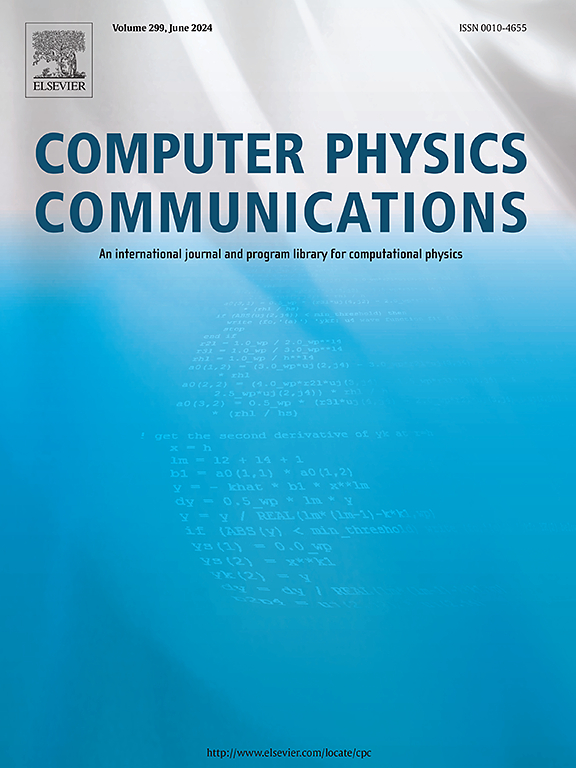神经-并行:利用时间并行化和神经算子对融合 MHD 仿真进行自我改进加速
IF 7.2
2区 物理与天体物理
Q1 COMPUTER SCIENCE, INTERDISCIPLINARY APPLICATIONS
引用次数: 0
摘要
目前正在组装国际热核聚变实验堆(ITER)聚变研究设施,以证明聚变可用于工业能源生产,同时全球其他几个计划也在推进之中,如欧盟-DEMO、CFETR、SPARC 和 STEP。托卡马克的高工程复杂性使其成为一个极具挑战性的优化设备,而基于测试的优化方法速度太慢、成本太高。因此,必须采用数字设计和优化,这就需要多物理场、多尺度高性能计算计算的强耦合套件。核聚变数字孪生体的安全监管、不确定性量化和优化无疑是一项埃级大挑战。在这种情况下,拥有代用模型来提供快速估算和不确定性量化,对于探索和优化新的设计方案至关重要。但问题在于:精确的代用模型训练首先需要模拟数据。大量工作已经探索了求解器在环解决方案,以最大限度地训练这种代用模型。同样,也有人提出了创新方法,利用代型加速传统的高性能计算求解器。在这里,我们设计了一种新方法来实现这两点。通过将神经算子和高性能计算方法结合在一起,实现了一个自我完善的框架。随着越来越多的仿真在该框架内运行,代用程序会不断改进,而高性能计算仿真则会不断加速。在与核聚变相关的 MHD 模拟中,基于傅立叶神经算子的代理被用来为 Parareal(时间并行化)方法创建神经粗解器。Parareal 与大型 HPC 模拟特别相关,因为传统的空间并行化已经饱和,因此时间维度也需要并行化。这个神经-Parareal 框架是向利用 HPC 和 AI 融合迈出的一步,科学家和工程师可以从自动化、自我完善、越来越快的模拟中获益。这里开发的所有数据/代码均向社区开放。本文章由计算机程序翻译,如有差异,请以英文原文为准。
Neural-Parareal: Self-improving acceleration of fusion MHD simulations using time-parallelisation and neural operators
The fusion research facility ITER is currently being assembled to demonstrate that fusion can be used for industrial energy production, while several other programmes across the world are also moving forward, such as EU-DEMO, CFETR, SPARC and STEP. The high engineering complexity of a tokamak makes it an extremely challenging device to optimise, and test-based optimisation would be too slow and too costly. Instead, digital design and optimisation must be favoured, which requires strongly-coupled suites of multi-physics, multi-scale High-Performance Computing calculations. Safety regulation, uncertainty quantification, and optimisation of fusion digital twins is undoubtedly an Exascale grand challenge. In this context, having surrogate models to provide quick estimates with uncertainty quantification is essential to explore and optimise new design options. But there lies the dilemma: accurate surrogate training first requires simulation data. Extensive work has explored solver-in-the-loop solutions to maximise the training of such surrogates. Likewise, innovative methods have been proposed to accelerate conventional HPC solvers using surrogates. Here, a novel approach is designed to do both. By bootstrapping neural operators and HPC methods together, a self-improving framework is achieved. As more simulations are being run within the framework, the surrogate improves, while the HPC simulations get accelerated. This idea is demonstrated on fusion-relevant MHD simulations, where Fourier Neural Operator based surrogates are used to create neural coarse-solver for the Parareal (time-parallelisation) method. Parareal is particularly relevant for large HPC simulations where conventional spatial parallelisation has saturated, and the temporal dimension is thus parallelised as well. This Neural-Parareal framework is a step towards exploiting the convergence of HPC and AI, where scientists and engineers can benefit from automated, self-improving, ever faster simulations. All data/codes developed here are made available to the community.
求助全文
通过发布文献求助,成功后即可免费获取论文全文。
去求助
来源期刊

Computer Physics Communications
物理-计算机:跨学科应用
CiteScore
12.10
自引率
3.20%
发文量
287
审稿时长
5.3 months
期刊介绍:
The focus of CPC is on contemporary computational methods and techniques and their implementation, the effectiveness of which will normally be evidenced by the author(s) within the context of a substantive problem in physics. Within this setting CPC publishes two types of paper.
Computer Programs in Physics (CPiP)
These papers describe significant computer programs to be archived in the CPC Program Library which is held in the Mendeley Data repository. The submitted software must be covered by an approved open source licence. Papers and associated computer programs that address a problem of contemporary interest in physics that cannot be solved by current software are particularly encouraged.
Computational Physics Papers (CP)
These are research papers in, but are not limited to, the following themes across computational physics and related disciplines.
mathematical and numerical methods and algorithms;
computational models including those associated with the design, control and analysis of experiments; and
algebraic computation.
Each will normally include software implementation and performance details. The software implementation should, ideally, be available via GitHub, Zenodo or an institutional repository.In addition, research papers on the impact of advanced computer architecture and special purpose computers on computing in the physical sciences and software topics related to, and of importance in, the physical sciences may be considered.
 求助内容:
求助内容: 应助结果提醒方式:
应助结果提醒方式:


